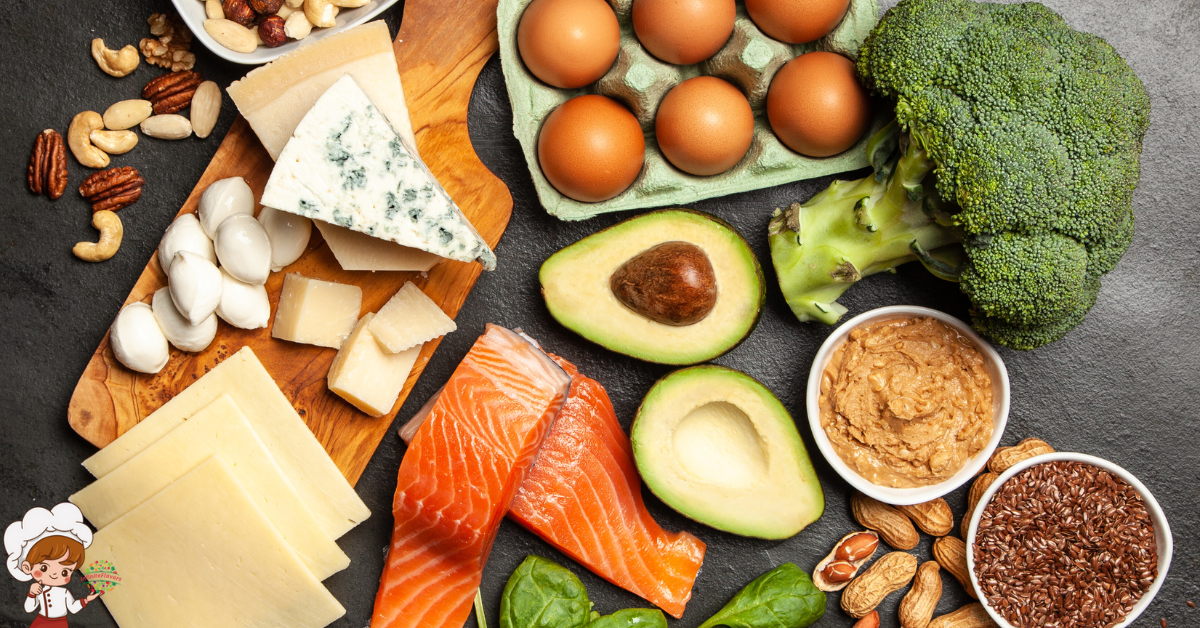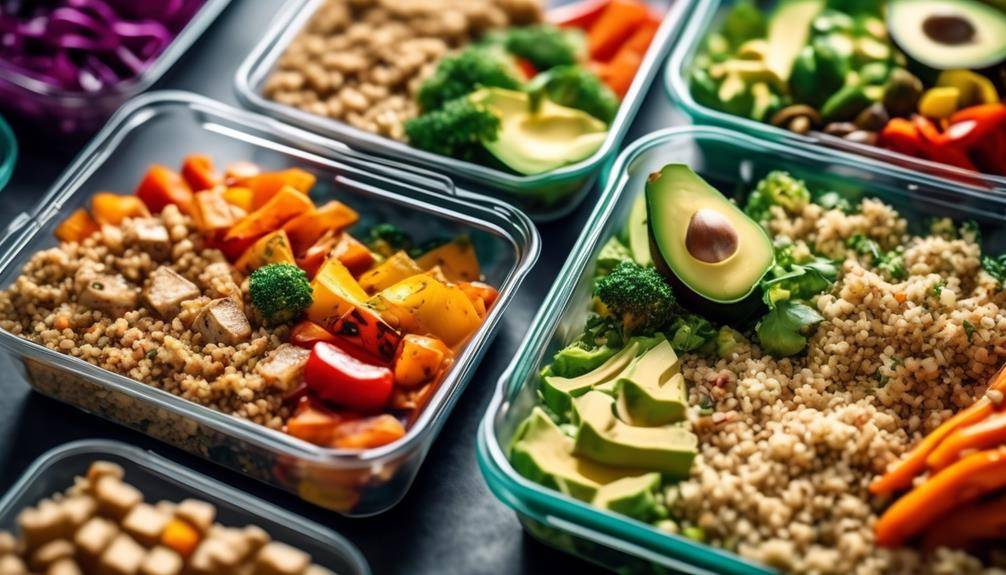Popular Ketogenic Diet Principles for Beginners

Are you ready to embark on a journey towards a healthier lifestyle? If so, the Ketogenic Diet Principles for Beginners might be just what you’re looking for. By focusing on high-fat, low-carb foods, this diet aims to put your body into a state of ketosis, where it burns fat for fuel instead of carbohydrates. But how exactly does it work? And what are the benefits? In this discussion, we will explore the principles of the ketogenic diet, giving you a solid understanding of its foundations and guiding you towards success. So, buckle up and get ready to uncover the secrets of this transformative diet.
What Is the Ketogenic Diet?
What exactly is the ketogenic diet and how can it benefit you? The ketogenic diet is a low-carb, high-fat diet that has been shown to help with weight loss, improve blood sugar control, and enhance cognitive function. The main principle behind the ketogenic diet is to shift your body into a state of ketosis.
Understanding ketosis is essential to understanding the ketogenic diet. Ketosis is a metabolic state in which your body starts using ketones, produced from fat, as its primary source of energy instead of glucose from carbohydrates. This shift in fuel source happens when you restrict your carbohydrate intake to a very low level, usually below 50 grams per day.
The science behind ketosis is fascinating. When you consume fewer carbohydrates, your body’s glycogen stores become depleted. As a result, your liver starts breaking down fats into ketones, which can be used by your brain and muscles for energy. This metabolic shift has several benefits. First, it allows your body to tap into its fat stores and burn them for fuel, leading to weight loss. Second, ketones have been shown to have neuroprotective properties, improving brain health and cognitive function.
Benefits of the Ketogenic Diet
The ketogenic diet offers a range of benefits that can enhance your overall health and well-being. One of the primary advantages of this diet is weight loss. When you follow a ketogenic diet, your body enters a state called ketosis, where it burns fat for fuel instead of carbohydrates. This shift in metabolism can lead to significant weight loss, as your body taps into its fat stores for energy.
In addition to weight loss, the ketogenic diet has been shown to improve mental clarity. By reducing your intake of carbohydrates and increasing your consumption of healthy fats, you provide your brain with a steady supply of ketones, which are a more efficient source of energy for the brain. This can lead to improved focus, concentration, and cognitive function.
Research has also shown that the ketogenic diet may have other health benefits, such as reducing inflammation, improving insulin sensitivity, and lowering the risk of certain diseases. Some studies have even suggested that the ketogenic diet may be beneficial for individuals with epilepsy, Alzheimer’s disease, and certain types of cancer.
It’s important to note that while the ketogenic diet can be beneficial for many people, it may not be suitable for everyone. If you have any underlying health conditions or are taking medication, it’s important to consult with a healthcare professional before starting the diet. Additionally, it’s important to ensure that you are getting all the necessary nutrients while following the ketogenic diet, as it can be restrictive in certain food groups.
Understanding Ketosis
Understanding ketosis is essential for grasping the principles of the ketogenic diet and its impact on your body’s metabolism. Ketosis is a natural metabolic state that occurs when your body doesn’t have enough glucose for energy and starts burning stored fats instead. In this state, your liver converts fatty acids into ketones, which can be used as an alternative fuel source.
To achieve ketosis, you need to follow a low-carbohydrate, high-fat diet. By restricting your carbohydrate intake, you force your body to switch from using glucose as its primary energy source to using ketones. This shift in metabolism has several benefits, including weight loss, improved mental clarity, and increased energy levels.
So, how do you know if you’re in ketosis? One of the most common signs is the presence of ketones in your urine or breath. You can use ketone test strips or a breathalyzer to measure the levels of ketones in your body. Additionally, you may experience a decrease in appetite, increased thirst, and a fruity odor in your breath.
It’s important to note that reaching ketosis can take time. It typically takes a few days to a week of following a strict low-carb diet to enter ketosis. However, everyone’s body is different, so the time frame may vary.
Click Here To Elevate your cooking game with our must-have kitchen essentials—because every great dish starts with the right tools! 🥄🍳✨
How Does the Ketogenic Diet Work?
To grasp how the ketogenic diet works, it is important to understand the metabolic process of ketosis. Ketosis is a metabolic state achieved on a ketogenic diet, where the body starts using ketones as its primary source of fuel instead of glucose.
When you follow a ketogenic diet, you significantly reduce your carbohydrate intake and increase your consumption of healthy fats. This restriction of carbohydrates forces your body to enter ketosis, where it begins to break down fats in the liver and produce ketones. These ketones are then used by the body as fuel, providing energy to your cells, including your brain.
Understanding the science behind ketosis is essential to understanding how the ketogenic diet works. By minimizing carbohydrate intake and increasing fat consumption, your body switches from relying on glucose for energy to relying on ketones. This metabolic switch has several benefits, including weight loss, improved insulin sensitivity, and increased mental clarity.
The role of ketones in fueling the body cannot be overstated. Ketones are a highly efficient source of energy, and when your body is in ketosis, it becomes adept at using them for fuel. This is particularly beneficial for weight loss, as it allows your body to tap into its fat stores and burn them for energy.
However, it is important to consider the potential long-term effects and sustainability of the ketogenic diet. While it has shown promising results for weight loss and overall health, it may not be suitable for everyone. It is always recommended to consult with a healthcare professional before starting any new diet or lifestyle change.
Macronutrient Ratios on a Ketogenic Diet
Achieving the right macronutrient ratios is crucial when following a ketogenic diet for optimal results. The macronutrients in question are fat, protein, and carbohydrates. On a ketogenic diet, the goal is to significantly reduce carbohydrate intake and increase fat consumption. This forces the body to enter a state of ketosis, where it primarily burns fat for energy instead of carbohydrates.
To achieve the essential macronutrient ratios on a ketogenic diet, it is important to track your intake. Generally, the ideal macronutrient breakdown for a ketogenic diet is approximately 70-75% fat, 20-25% protein, and 5-10% carbohydrates. This ratio ensures that your body remains in a state of ketosis, where fat is the primary source of fuel.
Tracking your macronutrient intake can be done using various tools and apps that provide nutritional information for different foods. These tools can help you monitor your fat, protein, and carbohydrate intake, allowing you to adjust your meals accordingly and maintain the desired macronutrient ratios.
Foods to Eat on a Ketogenic Diet
When following a ketogenic diet, it is important to focus on consuming approved ketogenic foods. These foods are low in carbohydrates and high in healthy fats. Some staples of a ketogenic diet include meat, fish, eggs, avocados, and certain dairy products.
Approved Ketogenic Foods
A ketogenic diet consists of a variety of approved foods that can be enjoyed while following this low-carb, high-fat eating plan. When meal planning for a ketogenic diet, it is important to focus on foods that are low in carbohydrates and high in healthy fats. Some approved ketogenic foods include fatty meats, such as beef, pork, and lamb, as well as poultry and fish. Non-starchy vegetables like leafy greens, broccoli, and cauliflower are also great choices.
Healthy fats like butter, coconut oil, and avocado oil can be used for cooking and adding flavor. Dairy products such as cheese, cream, and full-fat yogurt are allowed in moderation. Lastly, eggs, nuts, and seeds can provide additional protein and healthy fats. By incorporating these approved ketogenic foods into your meals, you can successfully follow this eating plan and achieve your health goals.
Ketogenic Diet Staples
To successfully adhere to a ketogenic diet, it is important to focus on consuming specific staples that are low in carbohydrates and high in healthy fats. When it comes to keto-friendly grocery shopping, prioritize foods such as fatty meats like beef, pork, and chicken, as well as fatty fish like salmon and sardines. Incorporate healthy fats like avocados, olive oil, and coconut oil into your meals.
Other staples include low-carb vegetables like spinach, broccoli, and cauliflower, as well as full-fat dairy products like cheese and butter. To make meal prepping easier, plan your meals in advance and batch cook proteins and vegetables. Having keto-friendly snacks on hand, such as nuts and seeds, can also help you stay on track. Remember to read food labels carefully to ensure they fit within your carbohydrate goals.
Foods to Avoid on a Ketogenic Diet
Eliminating certain foods is a crucial aspect of following a ketogenic diet for optimal results. To achieve and maintain a state of ketosis, where your body burns fat for fuel instead of carbohydrates, it is important to avoid certain foods that can hinder this process. The two main categories of foods to avoid on a ketogenic diet are processed carbs and sugary foods.
Processed carbs, such as white bread, pasta, and baked goods, are high in refined grains and have a high glycemic index. These foods cause a rapid spike in blood sugar levels, leading to increased insulin production. Insulin is a hormone that promotes fat storage and inhibits fat burning, making it counterproductive to the goals of a ketogenic diet. By avoiding processed carbs, you can help keep your blood sugar levels stable and maintain a state of ketosis.
Sugary foods, including candy, soda, and desserts, are obvious culprits when it comes to sabotaging a ketogenic diet. These foods are high in carbohydrates and can quickly kick you out of ketosis. Consuming sugary foods leads to a rapid rise in blood sugar levels, triggering an insulin response and preventing your body from utilizing fat as its primary fuel source. It is important to read food labels and be mindful of hidden sugars in sauces, dressings, and other packaged foods.
Meal Planning on a Ketogenic Diet
When it comes to meal planning on a ketogenic diet, understanding the essential macros for ketosis is crucial. This means focusing on high-fat, moderate-protein, and low-carb foods. By incorporating quick and easy recipes into your meal plan, you can ensure that you stay on track and maintain ketosis effectively.
Essential Macros for Ketosis
Achieving and maintaining ketosis on a ketogenic diet requires careful attention to the essential macros in your meal planning. These essential macros are fats, proteins, and carbohydrates. When following a ketogenic diet, it is important to consume a high amount of healthy fats, moderate amounts of protein, and very low amounts of carbohydrates. Fats are the primary source of energy in a ketogenic diet and are crucial for entering and maintaining ketosis. Proteins help in muscle growth and repair, while carbohydrates should be limited to help keep insulin levels low and promote fat burning. By focusing on these essential macros, you can maximize the benefits of ketosis, such as weight loss, improved mental clarity, and increased energy levels.
Quick and Easy Recipes
To continue your journey on a ketogenic diet, let’s explore some quick and easy recipes that will simplify your meal planning while staying in ketosis. Here are a few ideas to get you started:
- Quick breakfast recipes:
- Avocado and bacon egg cups: Simply line a muffin tin with bacon strips, crack an egg into each cup, and top with sliced avocado. Bake until the eggs are set.
- Keto smoothie: Blend together coconut milk, spinach, protein powder, and a tablespoon of nut butter for a filling and nutritious breakfast option.
- Chia seed pudding: Mix chia seeds with unsweetened almond milk, a splash of vanilla extract, and your choice of low-carb sweetener. Let it sit overnight and enjoy in the morning.
- Simple dinner ideas:
- Baked salmon with roasted asparagus: Season a salmon fillet with salt, pepper, and lemon juice. Bake in the oven and serve with roasted asparagus spears.
- Cauliflower fried rice: Replace traditional rice with cauliflower rice and stir-fry it with your favorite vegetables, protein, and soy sauce.
- Zucchini noodles with meatballs: Spiralize zucchini into noodles and serve with homemade meatballs and marinara sauce.
These recipes are not only easy to prepare but also delicious and keto-friendly, making your meal planning a breeze.
Tips for Successful Ketogenic Dieting
For successful ketogenic dieting, it is crucial to adhere to the principles of low-carb, high-fat eating while incorporating strategies that optimize your progress. To stay on track with your ketogenic diet, consider meal prepping as a helpful strategy. Dedicate some time each week to plan and prepare your meals in advance. This way, you can ensure that you have keto-friendly options readily available and avoid succumbing to unhealthy food choices when you’re short on time or feeling hungry. Meal prepping also allows you to control the ingredients and portion sizes, making it easier to stay within your desired macronutrient ratios.
In addition to meal prepping, staying motivated is key to successful ketogenic dieting. Set clear goals for yourself and remind yourself of the reasons why you chose to follow a ketogenic diet. It can be helpful to track your progress, whether it’s through keeping a food diary, monitoring your weight and measurements, or using a mobile app. These tools can provide you with tangible evidence of your progress and help you stay motivated along the way.
Another tip for successful ketogenic dieting is to find a support system. Surround yourself with like-minded individuals who are also following a ketogenic lifestyle. Join online communities or local groups where you can share your experiences, ask questions, and receive support and encouragement. Having a support system can make your journey more enjoyable and less overwhelming.
Lastly, remember to be patient with yourself. Transitioning to a ketogenic diet may take some time for your body to adapt. Be prepared for potential challenges and setbacks, but stay committed to your goals. With persistence and the right strategies, you can achieve success in your ketogenic dieting journey.
Managing Side Effects of the Ketogenic Diet
When following a ketogenic diet, it’s important to be prepared for potential side effects. One common side effect is the “keto flu,” which can include symptoms like fatigue, headache, and irritability. To manage this, make sure to stay hydrated, increase your electrolyte intake, and gradually transition into the diet. Additionally, you might experience cravings for carbohydrates. To deal with cravings, try incorporating more healthy fats and protein into your meals, and distract yourself with other activities. Remember that these side effects are temporary and can be managed with proper strategies.
Navigating Keto Flu
Managing the side effects of the ketogenic diet, such as the keto flu, can be achieved through various strategies and lifestyle adjustments. To navigate the keto flu, consider the following:
- Increase your electrolyte intake: The keto flu often occurs due to an imbalance in electrolytes, such as sodium, potassium, and magnesium. Replenishing these minerals can help alleviate symptoms.
- Stay hydrated: Adequate hydration is crucial during the ketogenic diet, as it helps to flush out toxins and maintain overall well-being. Aim to drink plenty of water throughout the day.
- Take supplements: Certain supplements, such as exogenous ketones and MCT oil, can provide relief from keto flu symptoms. These supplements can help boost ketone production and provide quick energy.
Dealing With Cravings
To effectively manage cravings while on the ketogenic diet, prioritize strategies that promote satiety and support a healthy mindset towards food. Cravings management is crucial in maintaining a successful ketogenic lifestyle. One effective strategy is to opt for healthy alternatives when cravings strike. For example, if you crave something sweet, try satisfying your taste buds with a small portion of berries or a square of dark chocolate with a high cocoa content. If you crave something crunchy, reach for a handful of nuts or seeds instead of processed snacks.
Incorporating healthy fats, such as avocados or nut butter, into your meals can also help keep cravings at bay. Additionally, staying hydrated, getting enough sleep, and managing stress levels can further support your efforts in managing cravings while on the ketogenic diet. Remember, with a little planning and mindful choices, you can overcome cravings and stay on track with your ketogenic goals.
Increasing Electrolyte Intake
If you want to effectively manage the side effects of the ketogenic diet, it is important to prioritize increasing your intake of electrolytes. Electrolytes are essential minerals that help maintain proper fluid balance, nerve function, and muscle contraction in the body. When following a ketogenic diet, you may experience an imbalance in electrolytes due to the reduction in carbohydrate intake.
To manage keto electrolyte imbalance, consider increasing your sodium intake. Sodium is a crucial electrolyte that is often lost when following a low-carb diet. You can increase your sodium intake by adding sea salt to your meals or drinking bone broth. Additionally, it is important to consume adequate amounts of potassium and magnesium, which can be found in foods like spinach, avocados, and nuts. By prioritizing electrolyte intake, you can minimize side effects and maintain optimal health while on a ketogenic diet.
Exercise and the Ketogenic Diet
When incorporating exercise into your ketogenic diet, it is important to understand the impact it can have on your body’s fuel sources and overall performance. The ketogenic diet, which is low in carbohydrates and high in fat, is known for its ability to promote fat burning and weight loss. When you exercise while following a ketogenic diet, your body’s fuel sources shift from relying mainly on carbohydrates to using fat as its primary source of energy.
One of the benefits of incorporating exercise into your ketogenic diet is that it can enhance your body’s ability to burn fat. When you exercise, your body depletes its glycogen stores, which are the stored form of glucose in your muscles and liver. With limited glycogen stores on a ketogenic diet, your body turns to fat as its primary source of fuel. This can lead to increased fat burning and weight loss.
Additionally, exercise can improve insulin sensitivity, which is important for maintaining stable blood sugar levels. The ketogenic diet already helps regulate insulin levels by reducing carbohydrate intake. By exercising regularly, you can further enhance insulin sensitivity and improve your body’s ability to manage blood sugar levels effectively.
Incorporating exercise into your ketogenic diet can also improve your overall performance. Regular physical activity can increase your endurance, strength, and flexibility, allowing you to perform better in your workouts and daily activities. It can also help you maintain lean muscle mass, which is important for preserving your metabolic rate and preventing muscle loss during weight loss.
Tracking Progress on a Ketogenic Diet
Tracking your progress on a ketogenic diet is essential for staying motivated and ensuring that you are on track to achieve your health and weight loss goals. By monitoring your progress, you can make necessary adjustments to your diet and lifestyle to optimize your results. Here are a few ways to effectively track and measure your success on a ketogenic diet:
- Keep a food journal: Tracking your daily food intake allows you to see what you’re eating and identify any patterns or areas for improvement. It can help you identify any hidden carbs or sources of unhealthy fats that may hinder your progress.
- Monitor your ketone levels: Ketone testing strips or devices can help you measure the ketones in your urine, blood, or breath. These measurements can indicate whether your body is in a state of ketosis, where it is efficiently burning fat for fuel. Regularly measuring your ketone levels can help you stay accountable and ensure that you’re following a proper ketogenic diet.
- Track your weight and body measurements: Weighing yourself regularly and taking body measurements can provide objective data on your progress. It’s important to remember that weight loss may not always be consistent on a ketogenic diet due to fluctuations in water weight. Taking body measurements, such as waist circumference or body fat percentage, can give you a more accurate picture of your progress.
Keto-Friendly Snack Ideas
To satisfy your cravings while staying in ketosis, here are some delicious and keto-friendly snack ideas. When following a ketogenic diet, it’s important to choose snacks that are low in carbs and high in healthy fats. This will help keep your body in a state of ketosis, where it burns fat for fuel instead of carbohydrates. To make it easier for you to stay on track with your keto snacks, here are a few tips:
- Plan Ahead: Take some time each week to plan and prepare your keto-friendly snacks. This will ensure that you have healthy options readily available and prevent you from reaching for high-carb alternatives.
- Keep It Simple: Many keto-friendly snacks can be made with just a few ingredients. For example, you can make a quick and easy snack by wrapping a slice of deli meat around a piece of cheese or rolling up some smoked salmon with cream cheese.
- Get Creative with Veggies: Incorporate vegetables into your snacks to add fiber and nutrients. Consider making cucumber slices topped with cream cheese and smoked salmon, or try celery sticks filled with almond butter.
- Opt for Nuts and Seeds: Nuts and seeds are a great source of healthy fats and can be enjoyed in moderation on a ketogenic diet. Some keto-friendly options include almonds, walnuts, macadamia nuts, and pumpkin seeds.
- Don’t Forget About Fat Bombs: Fat bombs are high-fat, low-carb snacks that can help satisfy your cravings and keep you in ketosis. They are typically made with ingredients like coconut oil, nut butter, and unsweetened cocoa powder.
Frequently Asked Questions About the Ketogenic Diet
Are you curious about the ketogenic diet? You may have heard some common misconceptions about keto, but it’s important to separate fact from fiction. In this section, we will address these misconceptions and provide evidence-based information about the health benefits of the ketogenic diet.
Common Misconceptions About Keto
One common misconception about the ketogenic diet is that it is a high-protein diet. While it is true that protein is an essential component of the diet, the primary focus of the ketogenic diet is on high fat intake and low carbohydrate intake. This misconception arises from the fact that many people associate low-carb diets with high-protein diets. However, consuming excessive amounts of protein can actually hinder the body’s ability to enter into a state of ketosis.
Other common misconceptions about the ketogenic diet include:
- Ketosis is dangerous: Some people believe that ketosis is a harmful state for the body to be in. However, research suggests that ketosis is a natural metabolic state that can be achieved safely and has numerous health benefits.
- The ketogenic diet is only for weight loss: While weight loss is a common goal for people following the ketogenic diet, it is not the only benefit. The diet has been shown to improve blood sugar control, reduce inflammation, and enhance cognitive function.
- The ketogenic diet is unsustainable: Many people believe that the ketogenic diet is difficult to maintain in the long term. However, with proper planning and education, it is possible to follow the diet while still enjoying a variety of delicious and nutritious foods.
Health Benefits of Keto
The ketogenic diet offers numerous health benefits that can positively impact your overall well-being. One of the most well-known benefits is weight loss. By restricting carbohydrates and increasing fat intake, the body enters a state of ketosis, where it burns fat for fuel instead of carbohydrates. This can lead to significant weight loss, especially in the initial stages of the diet.
Additionally, the ketogenic diet has been shown to improve cognitive function. The brain is fueled by ketones, which are produced during ketosis. This can enhance mental clarity, focus, and overall brain function. Studies have also suggested that the ketogenic diet may have potential therapeutic benefits for conditions such as epilepsy, Alzheimer’s disease, and Parkinson’s disease. Overall, the ketogenic diet can offer a range of health benefits, making it worth considering for those looking to improve their well-being.
Ketogenic Diet Principles for Beginners; Frequently Asked Questions
Can I Drink Alcohol on a Ketogenic Diet?
Yes, you can drink alcohol on a ketogenic diet, but it’s important to be mindful of your alcohol consumption. Opt for low-carb options like dry wine or spirits mixed with sugar-free mixers. Moderation is key.
Can I Follow a Ketogenic Diet if I Am Vegetarian or Vegan?
Yes, you can follow a ketogenic diet if you are vegetarian or vegan. It is possible to adapt the principles of the ketogenic diet by focusing on plant-based fats and protein sources.
How Long Does It Typically Take to Reach Ketosis?
On average, it takes a few days to a week to reach ketosis. To speed up the process, focus on consuming a low-carb, high-fat diet and stay consistent with your food choices.
Can I Have Cheat Days or Meals on a Ketogenic Diet?
Yes, you can have cheat meals on a ketogenic diet, but it may delay or kick you out of ketosis. Remember, consistency is key to reaping the full benefits of the ketogenic diet.
Are There Any Health Risks or Concerns Associated With a Ketogenic Diet?
There can be health risks and concerns associated with a ketogenic diet, such as nutrient deficiencies and potential liver and kidney issues. It’s important to consult with a healthcare professional before starting any new diet, especially for long term effects.
Conclusion
In conclusion, the ketogenic diet is a low-carb, high-fat diet that can provide numerous health benefits. By inducing a state of ketosis, where the body burns fat for fuel instead of carbohydrates, the diet can help with weight loss, increased energy levels, and improved mental focus. It is important to maintain proper macronutrient ratios and track progress while following this diet. With the right knowledge and planning, the ketogenic diet can be a practical and effective approach to achieving your health and fitness goals.








